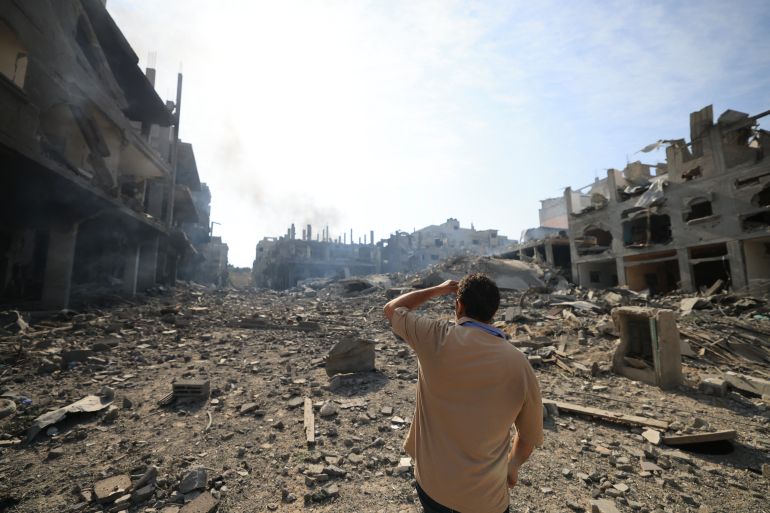Analysis: Why did it take Israel three days to return to Gaza’s boundary?
The Israeli army took more time than expected to clear the area that Hamas took in its surprise dawn raid.

Israel has announced that on Tuesday its forces retook the territory up to the boundary of the Gaza Strip.
Hamas fighters on the ground did not offer any significant opposition to the deployment of the Israeli army, but they almost certainly never intended to resist the return of Israeli soldiers.
Keep reading
list of 3 itemsPhotos: Rimal neighbourhood, the beating heart of Gaza, wiped out
First plane carrying US ammo lands in Israel as troops mass near Gaza
Indeed, the primary military purpose of Hamas’s operation on Saturday seems to have been to demonstrate, to Israelis, Arabs and the world, its capability to attack multiple locations across the frontier of Gaza and take over significant territory in a series of coordinated lightning strikes.
Hamas achieved this goal swiftly and efficiently by the skilful use of surprise and tactical innovation and in doing so achieved a secondary military goal of testing the Israeli army’s tactics and equipment, also with unprecedented success.
A step too far?
Gory scenes from a number of military and civilian locations that Hamas took by surprise within hours of the start of the dawn operation are a strong indication that the operation did not have purely military goals.
Taking enemy combatants and using prisoners of war as bargaining chips for future negotiations is a military practice as old as human conflict itself. But the Hamas fighters embarked on a rampage unprecedented even in previous Israeli-Palestinian confrontations, spreading fear through what was widely reported as the indiscriminate murder of hundreds of civilians and captives.
Finally, they took back into the Gaza Strip a yet unknown number of prisoners and hostages, believed to be over 100, including foreign nationals.
Caught unawares, the Israeli military responded quickly, predictably, and in the easiest way, by aerial bombing targets inside Gaza. What they hit and on what logic is a subject for future in-depth analysis, but it is safe to assume that the real aim of the bombing was to demonstrate force, show the shocked Israelis that their army was not knocked out, that it was hitting back.
The unprecedented degree of strategic surprise and deception achieved by the Palestinian side indicates careful planning, so it is unlikely that Hamas was caught unprepared by the expected Israeli bombing. Most military hardware was probably moved and hidden well before the knee-jerk Israeli air attacks.
The profound humiliation that Israeli intelligence and military suffered on Saturday resonated deeply and painfully within the country’s defence establishment. Operational earthquakes of such magnitude, rare in modern combat, send shockwaves wide and deep.
A slower-than-expected pace
A side that gets punched so hard must activate its worst-case scenarios. Following such a drastic failure to predict an attack and prepare for it, the Israeli military and secret services must have had to account for the possibility of having suffered a deep security breach and assume that their operational plans had been compromised.
Headquarters of every force in the world prepare in peacetime by conducting war games, brainstorming sessions, simulations and exercises to predict all possible variants of their enemies’ actions and find the best and most efficient ways of countering them.
It is unlikely that Tzahal, as the Israeli army is known, had contemplated this kind of attack. There was certainly a general plan of what to do should Palestinian fighters break out from Gaza into Israel but they probably never anticipated this level of complexity, improvisation and innovation.
Under normal circumstances, generals immediately choose the most appropriate plan and activate it; units are given their initial orders and can move quickly, adapting the war plan to the situation on the ground.
Not this time. With the possibility that Hamas somehow spied on Israel and obtained the battle plans, they had to be treated as compromised and be discarded and new plans had to be outlined in a very short time, a gargantuan task.
This means that the relatively slow response by Israeli ground forces who took almost three days to get to the Gaza border is no surprise.
A well-equipped, fully mechanised army like the Israeli one certainly can recover the couple of hundred square kilometres of easy, flat land that Hamas took in its attack in a matter of hours, at most a full day.
So why were Israeli Merkava tanks not at the separation fences of Gaza on Saturday or Sunday?
There are several possible reasons and more will be known in time. But it is obvious that they could not count on forward operating bases closest to the border because those had been overrun and tanks and armoured personnel carriers that were meant to be first responders were destroyed or captured by Hamas.
Israel surely has lots of reserves, one would argue, could it not deploy them faster in such a small country? It could, if it did not have to count on the possibility of being forced to use its soldiers and equipment elsewhere.
As mentioned, more will be known in time about how events unfolded. For now, the analysis has to be marked as: to be continued …